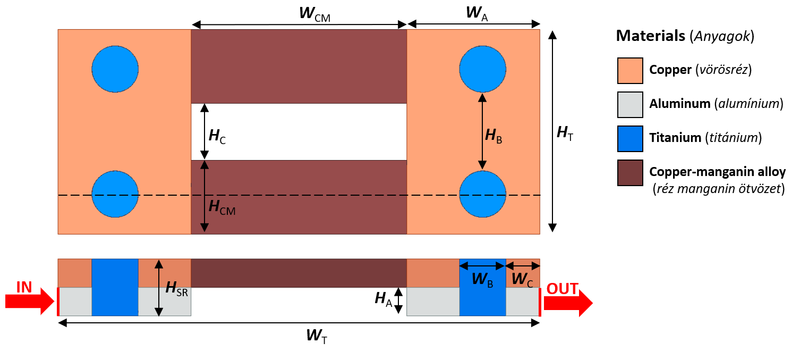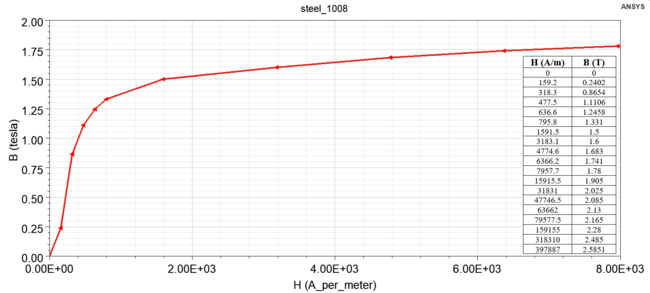Difference between revisions of "Homework Assignment"
(→Calculating the resistance and the total loss of the shunt resistor by finite element method) |
(→Calculating the resistance and the total loss of the shunt resistor by finite element method) |
||
| Line 69: | Line 69: | ||
The geometry dimensions for your task you can find in the following table: [https://docs.google.com/spreadsheets/d/1cieVgmu9ALZBLYRZyxL-eHe27nOpavBuOGftaLXCC9I/edit?usp=sharing '''Semester Assigment''']. | The geometry dimensions for your task you can find in the following table: [https://docs.google.com/spreadsheets/d/1cieVgmu9ALZBLYRZyxL-eHe27nOpavBuOGftaLXCC9I/edit?usp=sharing '''Semester Assigment''']. | ||
| − | The task: | + | This task is a current conduction problem. The solved equation is |
| + | <math>\nabla\cdot\sigma\nabla \varphi=0</math>. | ||
| + | |||
| + | |||
| + | The task: determine the voltage drop, the resistance and the ohmic loss of the problem.<br \> | ||
The voltage drop is the potential difference between the two terminals of the arrangement. You can determine resistance using Ohm's law: | The voltage drop is the potential difference between the two terminals of the arrangement. You can determine resistance using Ohm's law: | ||
Revision as of 18:33, 14 February 2022
|
Analysis of Shunt Resistor | ||
|
Instructor
|
Teaching Assistants:
| |
Aim of Assignment
Students will learn the basics of electromagnetic field calculations, their main steps, and gain practice in evaluating results and writing a Technical Report that meets international expectations.
Knowledge needed to solve the problem
- The main steps of the finite element method;
- Theoretical knowledge of the static magnetic field (for defining materials, for excitation);
- Knowledge of CAD system to create geometry;
- Download and install Ansys Electronics Desktop Student.
The Semester Assignment
The task consists of two parts, a basic task, with a faultless solution of up to 70%, and an extra task, with an additional maximum of 30%.
Deadline - Output Form: PDF format. Color drawings should be made so that their contents are clear to the reader in black and white. Language English Place of submission: In Moodle system. Late submission: After every day started, a 5% deduction from the achieved result (i.e. after 5 days delay 100% can only be obtained up to 100% - 5x5% = 75%). Evaluation: 0 - 48% - Insufficient [F] (1) 50 - 59% - Sufficient [D] (2) 60 - 70% Satisfactory [C] (3) 71 - 84% Good [B] (4) 85 - 100% - Very good [A] (5) For the formal requirements, the requirements of CFD and mechanics are also valid here.
Part I of the Assignment
Calculating the resistance and the total loss of the shunt resistor by finite element method
The geometry dimensions for your task you can find in the following table: Semester Assigment.
This task is a current conduction problem. The solved equation is [math]\nabla\cdot\sigma\nabla \varphi=0[/math].
The task: determine the voltage drop, the resistance and the ohmic loss of the problem.
The voltage drop is the potential difference between the two terminals of the arrangement. You can determine resistance using Ohm's law:[math]R = \frac{U}{I}[/math],
then the ohmic loss
[math]P = I^2\cdot R[/math]
where [math]U[/math] is the voltage drop, [math]I[/math] is the current and [math]R[/math] is the resistance.
Properties of materials. Anyag Titanium Copper Aluminum Copper-manganin alloy [math]\sigma~[\text{MS/m}][/math] 1.82 58 38 20.833 [math]\rho~[\text{kg}/\text{m}^3][/math] 4500 8933 2689 8400 [math]c_{\text{P}}~[\text{J}/(\text{kg}\cdot\text{°C})][/math] 522 385 951 410 [math]\lambda~[\text{W}/(\text{m}\cdot\text{°C})][/math] 21 400 237.5 22 Tasks
- Define the problem type based on the given parameters;
- Creating and specifying the task geometry in Ansys Electronics Desktop Student;
- Run the FEM simulation;
The results of the simulations. Software Discovery AIM Maxwell 3D FEMM Maxwell 2D Force [N] 3,586 3,582 3,542 3,587 Inductance [mH] 39,88 39,84 39,71 39,84
- Test of the surrounding region's size as a function of force;
- Energy, force, inductance in the function of the number of finite elements (Triangle);
- Postprocessing [at least two of the below]:
- 1) determination of force and inductance;
- 2) displaying equipotential lines;
- 3) display the magnetic field strength;
- 4) displaying magnetic flux density vectors.
- Preparation of a Technical Report based on the use of the above results.
Note: The “Part I of the Assignment” elements will be reviewed in detail during the exercise to prepare and run a simulation model for an electromagnetic task. On this basis, students can easily complete Part I of the Assignment by attending the exercises.
- Parameters for this Assignment:
- Relative permeability of air and coil [math]\mu_r = 1[/math];
- The excitation of the coil (To validate the results): [math]I=0.76~\text{A}[/math], [math]N=789~\text{turns}[/math] (DC);
- Magnetic curve of the core and plunge:
Figure 1. - Steel 1008 steel magnetization curve. Part II of the Assignment
Determining the force acting on the moving part of the problem (plunger) and the inductance of the coil as a function of displacement.
Note: This task corresponds to the solenoid valve in internal combustion engines that controls the injection.
- Specific tasks
- Considering the plunger movement to the initial state (2mm air gap) from [math]-1.8\text{mm} \text{ to } 10\text{mm}[/math] (at least in 7 positions). Detailed instructions on the solution will not be available.
- This part is intended to measure the degree of autonomy, initiative and diligence of the student, i.e.:
- is the student able to do independent work;
- to design, assemble and run the simulation alone.
References

